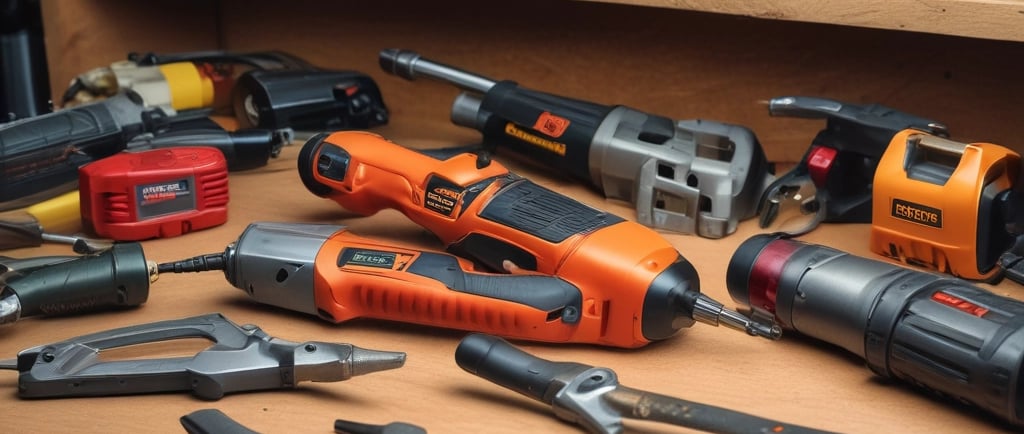Tool Safety for Beginners: The Black+Decker Edition
BLACK+DECKER GENERAL
10/16/20255 min read


Understanding Common Hand Tools
For beginners venturing into the world of DIY projects, familiarity with essential hand tools is crucial. Black+Decker offers a wide array of hand tools that serve various purposes in home improvement and repair tasks. Learning about these tools, their functions, and proper usage will greatly enhance one's ability to work safely and efficiently.
One foundational tool is the screwdriver, which comes in multiple varieties like flathead and Phillips. Each type is designed to insert or remove screws effectively. Understanding the difference between these screwdrivers is key; using the wrong type can lead to stripped screws or damaged surfaces. Selecting a screwdriver that matches the screw head ensures safer handling and more effective results.
Hammers are another staple in the toolbox, primarily used for driving nails into surfaces. The traditional claw hammer, which features a flat side for striking and a claw for removing nails, is versatile and essential for many projects. When using a hammer, proper grip and precise striking technique are necessary to avoid accidents.
Pliers come in various forms, including needle-nose and adjustable pliers, serving diverse uses such as gripping, twisting, or cutting. These tools are particularly useful for tasks in tight spaces or when manipulating wires. Beginners should pay attention to how to adjust and handle pliers properly, as improper use can lead to injury or damage to the materials being worked on.
Also included in the list of essential hand tools are wrenches, which are designed for tightening or loosening nuts and bolts. Similar to screwdrivers, wrenches come in different sizes and types, such as adjustable wrenches, ensuring compatibility with various fasteners. Choosing the right size and type is crucial for safety and effectiveness.
In summary, comprehending the purpose and proper usage of these common hand tools is vital for beginners. Selecting the appropriate tool for each job and understanding the specifications of each tool contribute significantly to safe and efficient handling, paving the way for successful DIY projects.
Power Tool Safety Guidelines
Power tools have revolutionized the way projects are completed, but with their convenience comes the necessity for adherence to strict safety guidelines. When using Black+Decker power tools, it is vital to understand the importance of personal protective equipment (PPE). Protective gear such as safety goggles, gloves, and ear protection should always be worn to minimize the risk of injury. For instance, safety goggles shield the eyes from debris, while ear protection helps prevent hearing damage from loud tools.
Proper grip and control of tools are also essential for safe usage. When operating a power drill or saw, users should maintain a firm grip, ensuring control over movements and stability. It is advisable to keep both hands on the tool, steadying it against the material being worked on. Maintaining awareness of your surroundings is crucial as well; ensure that the workspace is clear of hazards and that others are at a safe distance while operating these powerful tools.
Black+Decker power tools come equipped with various essential safety features. For example, many drills have built-in safety clutches that prevent over-tightening, while saws often include blade guards to protect the user from contact with dull or exposed blades. Familiarizing oneself with these features can enhance safety significantly.
Before each use, conducting a thorough inspection and maintenance of the tools is indispensable. Check for any signs of wear or damage, and ensure that cords and plugs are intact. Regular maintenance, such as lubricating moving parts and cleaning debris from the tool surfaces, not only ensures reliability but also prolongs the life of the equipment. Following these guidelines will not only maximize safety but will also enhance the overall experience while working with Black+Decker power tools.
Best Practices for Tool Storage and Organization
Proper tool storage and organization are critical components in maintaining safety and preventing accidents when working with tools, particularly for beginners using Black+Decker products. An organized workspace minimizes hazards and ensures that tools are easily accessible, reducing time spent searching for them. Moreover, adhering to specific storage practices helps in keeping tools in good condition, thereby prolonging their lifespan.
One effective method of organizing Black+Decker tools is by utilizing toolboxes. A solid toolbox not only provides a durable storage solution but also aids in keeping the tools protected from dust and moisture. It is advisable to classify tools within the toolbox, grouping them by type or frequency of use. This systematic approach allows for quick identification and retrieval, thereby enhancing both safety and efficiency.
Pegboards are another versatile option for tool organization. By mounting a pegboard on the wall, users can hang various tools at eye level, making them both visible and accessible. This approach encourages a clean workspace and allows for easy identification of which tools are readily available. Additionally, using labeled hooks or bins can further streamline organization efforts, ensuring that each tool has a designated place.
Racks, shelves, and cabinets are ideal for storing larger tools and equipment. Keeping these items off the floor not only reduces clutter but also prevents potential trip hazards. It is crucial to place heavier tools on lower shelves for easy access and to avoid accidents caused by lifting overhead.
Safety is paramount, especially when children and pets are present in the home. Tools should be stored in secure locations, ideally locked away or placed out of their reach. Regular inventory checks are also recommended to ascertain the condition of the tools, identifying any that may require maintenance or replacement. By adopting these best practices for tool storage and organization, users can foster a safer environment conducive to both productivity and safety.
Essential Emergency Procedures and First Aid
When engaging with tools like those from Black+Decker, it is imperative for beginners to be acquainted with essential emergency procedures and first aid techniques specific to tool-related injuries. Accidents can happen, and being equipped with the right knowledge can significantly mitigate their severity. Common accidents include cuts, abrasions, electric shocks, and tool malfunctions. Each of these scenarios requires a swift and informed response.
For minor cuts and abrasions, the first step is to stop the bleeding. Apply gentle pressure with a clean cloth or bandage until the bleeding stops. Afterward, clean the wound with soap and water to prevent infection, and apply an antiseptic ointment before covering it with a bandage. It is crucial to monitor the injury for any signs of infection, such as increased redness or swelling.
Electric shocks can occur if safety precautions are not observed while using power tools. In the event of an electric shock, turn off the power source immediately and do not touch the victim until the electrical source has been safely disconnected. If the person is unresponsive or experiencing difficulty breathing, call emergency services immediately and begin CPR if trained to do so.
Having a well-stocked first aid kit readily accessible in your workspace is essential. Each kit should contain adhesive bandages, antiseptic wipes, gauze, and medical tape, among other first aid supplies. Additionally, creating a clear emergency plan is recommended. This plan should determine who is responsible for calling for help, the nearest medical facility, and the quickest route there.
Lastly, understanding when to seek professional medical assistance is crucial. If an injury appears severe, does not improve within a few days, or shows signs of infection, then medical help should be sought without delay. By being prepared and informed on these procedures, beginners can enhance their safety and effectively respond to emergencies that might arise during their tool usage.
